|
Second
Season Landmarks
The Second Season of VTTBOTS premiered
on September 19, 1965, and displayed the most sweeping changes
the show would ever see. Major format changes included the switch
to color, plus the show was now aired on Sunday nights at 7:00,
where it would remain. The number of episodes was reduced to
26.
This season saw the first two-part story arc, which would become
an annual tradition. The themes of the first season carried
over, but with the scales tipped towards science-fiction. The
color and a big budget gave the second year the most epic look
of the series. Other significant changes would include two new
crew members, a dynamic new vehicle, the Flying Sub, and new
credits. Even a new theme tune was introduced, though quickly
dropped.
| The
Diving Bell acquired spotlights over her three main portholes
and ladder rungs on her hull. Occupants wore green pullover
sweaters. The Bell was more self-contained as of Season
Two as only the suspension cable was used. The Mini-Sub
was unchanged. Most changed was Seaview herself. (Many of
these changes make sense if viewed after Season One's "Submarine
Sunk Here" where the ship was salvaged and repaired.)
Several of the changes were necessitated by the addition
of the Flying Sub. |
|
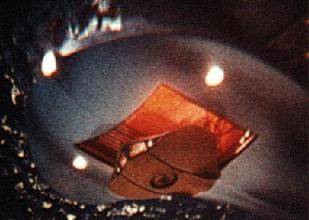
Changes necessitated by the addtion of
the Flying Sub.
|
| New design characteristics included: |
1. The
Observation Lounge became the Flying Sub Access Bay.
2. The Control
Room now extended forward to the observation windows. This change
finally gave the crew direct vision forward.
3. The observation
windows were reduced from eight panes to four. These four windows
actually lined up better with the interior set design, as the
eight windows were never apparent from inside. The windows finally
acquired shutter panels, variously called "Crash Doors"
or "the Collision Screen."
4. The Control
Room was widened (to the joy of the directors), and the computer
was moved from rear starboard to port, adjacent to the Periscope
Island.
5. Retractable
crash doors were added to the previous forward Control Room bulkhead.
When these were closed, the chart table was isolated forward in
the Observation Nose.
6. The spiral
staircase now started at the Control Room level and led upwards
to Officer's Country.
7. The Observation
Nose control console was deleted. The Flying Sub hatch and railing
were new.
8. The antique
car-sounding dive/emergency siren was replaced by a new klaxon.
9. The Diving
Lock in the Missile Room was updated with a more elaborate hatch
and an electronics console replacing the wheel mechanism.
10. Moving
to the exterior, the Seaview was now medium blue.
11. The new
viewports changed the "face" of the ship. The searchlight
casing was deleted.
12. The dorsal
sonar dome was deleted, and replaced by twin sonar bulges at the
ship's "temples".
13.
The Flying Sub bay doors were instantly obvious, and the
keel spotlights were moved outboard to allow room for the
doors.
14.
The full-size Seaview dock set was gone, but the Conning
Tower set was retained. When the dock area was shown, it
was no longer in a cave-like subterranean setting, but obviously
at sea-level and bathed in daylight. This might have been
in keeping with the show's lighter Second Season tone, but
it radically altered the protected subterranean "feel"
of Seaview's docking area. It was still plainly labelled
Dock A.
|
|
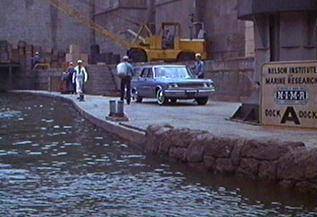
No longer shadowed, Seaview's dock sees
sunlight.
|
15. As for uniforms, the traditional sailor
suits
were changed to red or blue jumpsuits. An exception was crewman
Ron who occasionally wore gray. The colors did not appear to signify
anything (rank, department, etc.), but for the record, Kowalski
always wore red. (Officer uniforms were unchanged.)
For all these
changes, the transition was a smooth one, retaining the great
character of VTTBOTS. The show was so strong, the whole was greater
than the sum of the parts. In Voyage's second season, Winton
Hoch took the Emmy for cinematography and L.B. Abbott and Howard
Lydecker received the Emmy for photographic effects
The following
are Episode Specific Landmarks:
| 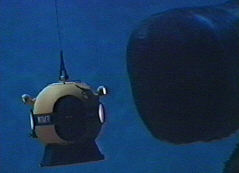
Apple One about to get a nudge.
|
|
Episode
1, "Jonah And The Whale":
Season Premiere! Nominated for an Emmy (deservedly so).
The definitive Diving Bell story and one of the best whale
stories. All of the Second Year changes are introduced,
with the exception of the Flying Sub and various crash doors.
(The Flying Sub is suggested by the appearance of the entry
hatch and railing in the Observation Nose, and the bay doors
visible on the Seaview's belly.
Most significant were the closing
credits which featured a still of the Flying Sub diving
to the ocean. Scores of viewers |
must have been bewildered
by that image. Luckily, they only had to wait one week to find
the answer! This closing image remained throughout the second
season.) The opening credits are new because of the color, and
feature a confusing mixture of old and new Seaviews. (This would
be corrected with the ninth episode.) A new theme by Jerry Goldsmith
is tried, but lasts this one episode (Although great, this theme
was rather dark and brooding. The decision to return to the original
theme might also have been that this was "one change too
many.")
The
Diving Bell is called "Apple One". First appearance
of Chief Francis Ethelbert Sharkey. First appearance of Stu Riley.
One of the wittiest lines of the series: (Katya) "Jonah of
course was a very poor sailor,though perhaps, he would've made
a good admiral."
Episode
2, "Time Bomb": First appearance
of the Flying Sub! Nelson refers to her as the "vehicle".
(ABC publicity referred to her as the "Flying Fish".)
She is also known as "FS-1", although, technically there
will be more than one in the series. (Speaking of "landmarks",
the Flying Sub of VTTBOTS has to stand out as one of the most
unique and beautiful vehicles in the history of science fiction.)
The Paul Sawtell theme returns. Nelson has his only romantic moment
in the series. First time Sharkey is called "Francis"!
Episode
3, "...And Five Of Us Are Left":
First use of the Observation Windows collision screen. First loss
of a Flying Sub. Crane's only romantic moment in the series.
Episode 5,
"Escape From Venice": The famous episode where Crane
must memorize a tune. ("La-la-la...") Music by Nelson
Riddle. First use of the Control Room retractable crash doors.
Episode
6, "The Left-Handed Man": Harriman
Nelson owns a 1965 Imperial Crown Convertible. The only glimpse
of his home also.
Episode
7, "The Deadliest Game": The only
episode in the entire series where the Seaview, Flying Sub, Diving
Bell, and Mini-Sub are all utilized! The Diving Bell is again
called "Apple One" and is lowered into an undersea bunker.
Chip operates the Mini-Sub (alas off-camera). First view of what
will become the Seaview's reactor.
Episode 9,
"The Peacemaker": New and exciting opening credits are
introduced. These are the familiar sonar scope overlying a diving,
refitted Seaview. After Basehart and Hedison, the Flying Sub leaves
the words "Created and Produced by Irwin Allen" in her
wake. This opening was used longer than any other, continuing
through Episode 8 of the Fourth Year, for a total of 53 episodes.
| 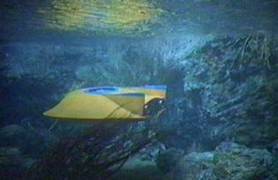
Brilliant miniatures in The
Silent Saboteurs.
|
|
Episode 10,
"The Silent Saboteurs": The most extensive Flying
Sub episode of the series. The only time the Flying Sub's
blackout shutters are used. The crew of FS-1 wear combat
fatigues. This one episode reverts to the original Second
Year opening credits.
Episode 11,
"The X Factor": The new opening credits return.
First toy factory to have a greenhouse!
Episode 12,
"The Machines Strike Back": Admiral Halder has
an (off-camera) undersea "transport". |
Episode
13, "The Monster From Outer Space":
The Flying Sub lands on an aircraft carrier. The first of four
appearances of Wayne Heffley as the Seaview's doctor.
Episode 14,"Terror On Dinosaur
Island": The only time the Seaview is beached! This sequence
is beautifully staged by L.B. Abbott’s effects department.
Episode 15,"Killers
Of The Deep": The VTTBOTS "war movie"!
Episode 16,
"Deadly Creature Below": One of the longest teasers--over
seven minutes. This was the episode used by View-Master for its
VTTBOTS set. View-master titled this set "Escape."
First use of the Seaview's pulldown laser control. First
time the Flying Sub is recovered by the Seaview.
Episode 17
, "The Phantom Strikes!": First episode to generate
a sequel! First ghost story. The Control Room is viewed
from the starboard side. (Interestingly, the preview shows Nelson
really shooting Crane in his cabin. In the actual episode, Nelson
throws the gun down in disgust.)
Episode
18,"The Sky's On Fire":
A remake of the film that started it all! Nelson's laptop
computer is decades ahead of its time. Last new footage
of Sharkey this season. The "Transformer Room"
is a preview of what will become the infamous Circuitry
Room in later years.
Episode
19, "Graveyard Of Fear":
A seaplane lands at the Nelson Institute. |
|
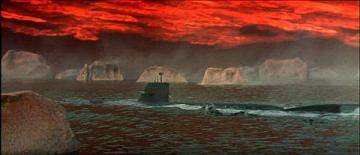
The Sky's On Fire! Familiar footage.
|
Episode 20,"The
Shape Of Doom": The only "undersea" close-ups of
the Mini-Sub's occupant. Due to stock footage, Ron is a quick-change
artist in this episode!
Episode 22,"The
Deathship": The VTTBOTS version of Agatha Christie's "Ten
Little Indians". Sadly, the final
appearance of the Mini-Sub in the series.
|
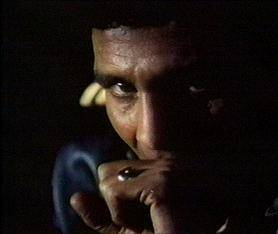
A tortured Crane in "Return
of the Phantom."
|
|
Episode
23,"The Monster's
Web": The original title of this episode was "Web
Of Destruction". A unique view of the Seaview through
the Flying Sub's viewports.
Episodes 24
and 25, "The Menfish/The Mechanical
Man": Admiral Nelson does not appear in these episodes
as Richard Basehart was ill.
Episode 26,
"The Return Of The Phantom": Season Finale. The
first sequel! The most erotic scene of the series (Maria's
dance). The last speaking and onscreen female guest star
of the series. (Vitina Marcus, credited as "Vitina",
in a dual role.)
|
|
![]()